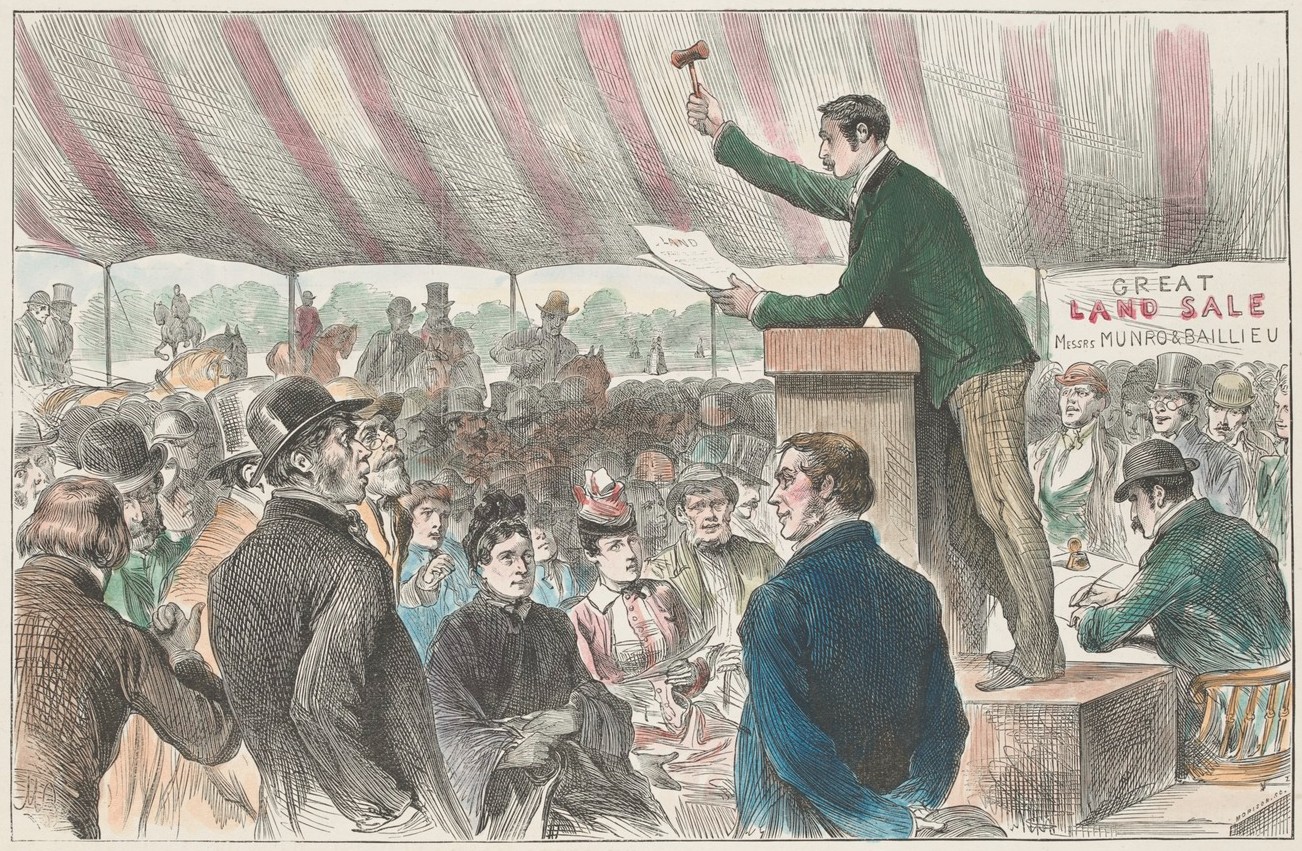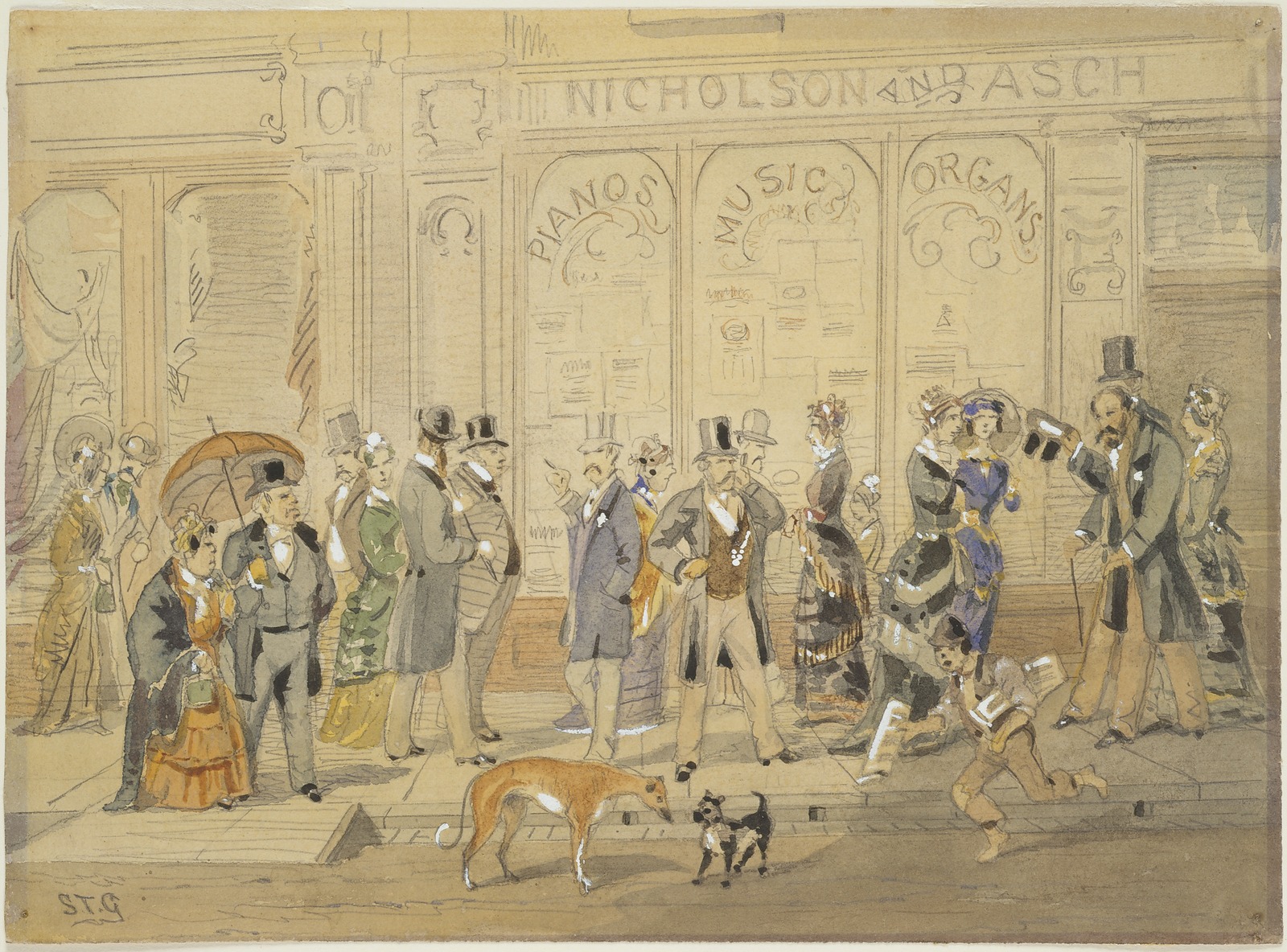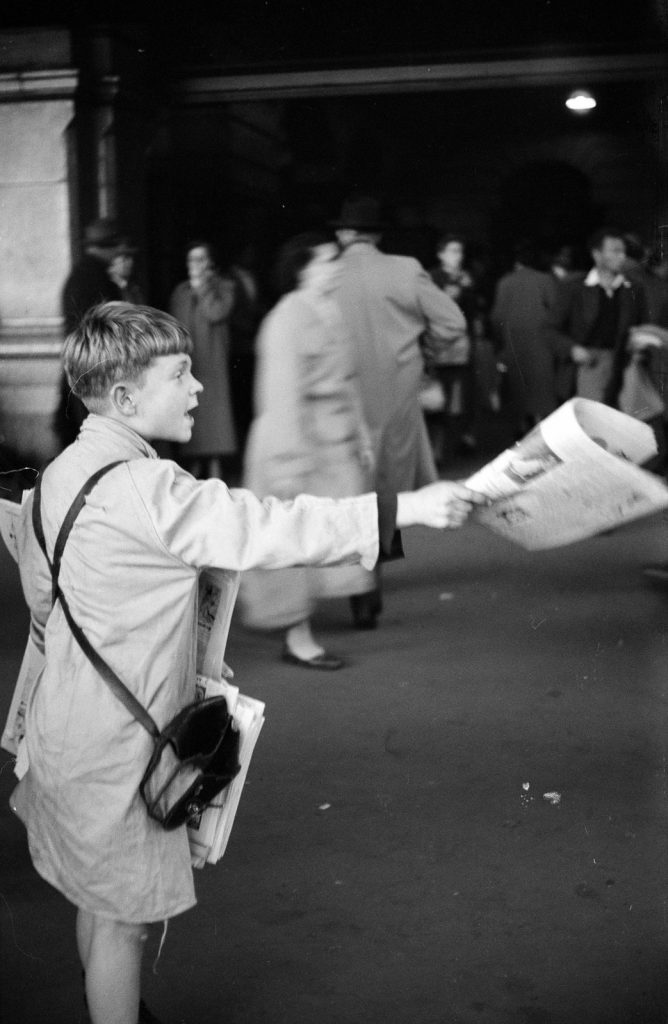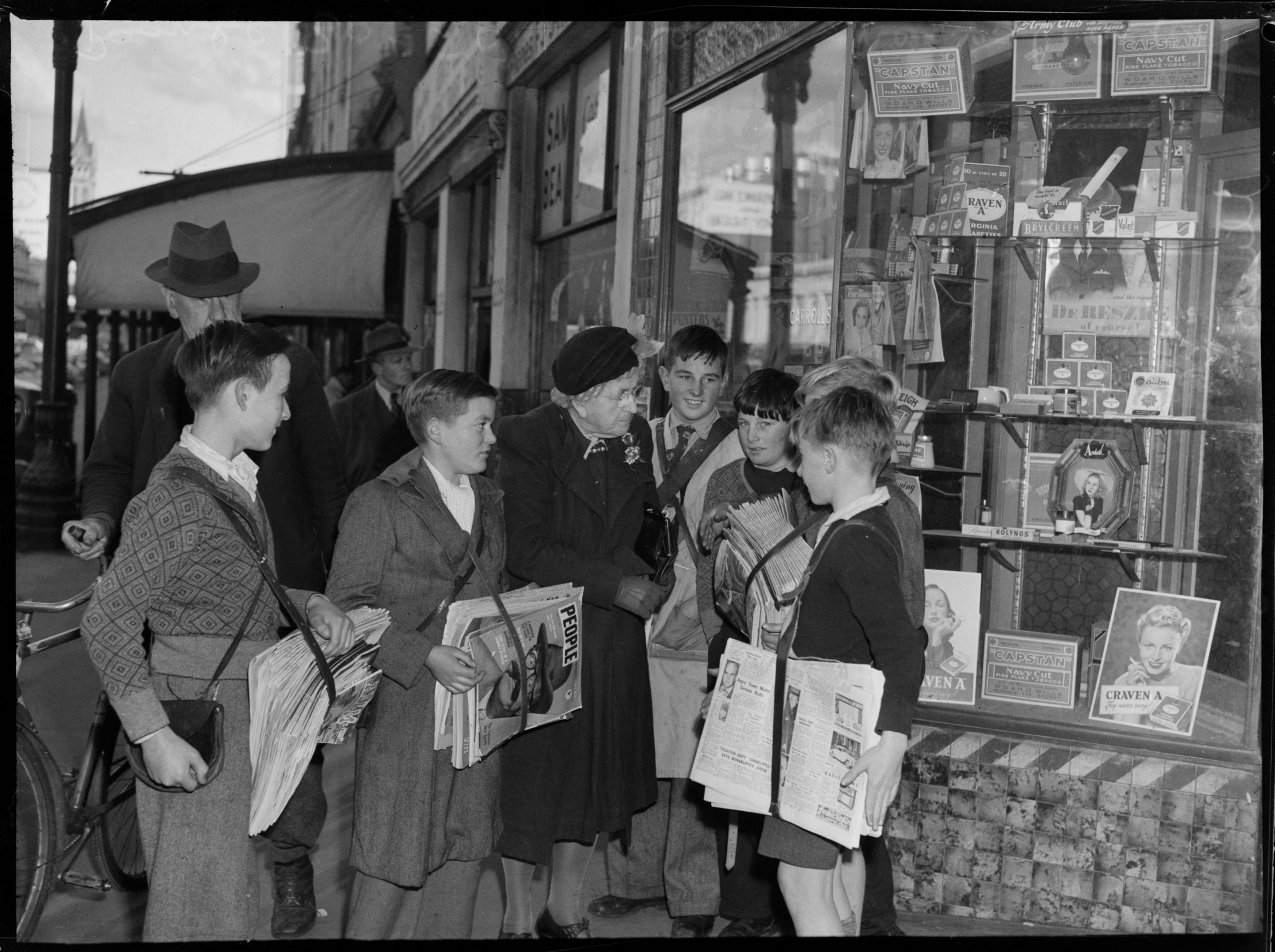From as far back as the 1850s, newsboys were a common sight on the streets of Melbourne. Most were poor and many were illiterate. Some boys had no homes to go to at all. The boys would purchase newspapers by the dozen, and then sell them individually to passers-by for a profit. Once they ran out of papers to sell, some boys would work on into the night, selling matches to drunks in the city’s public houses.
 A paper boy outside the Criterion Hotel in Greater Collins Street, Melbourne, 1854. Lithograph by S.T.Gill; H12610
A paper boy outside the Criterion Hotel in Greater Collins Street, Melbourne, 1854. Lithograph by S.T.Gill; H12610
When not selling papers, the boys had a reputation for roaming the alleyways: ‘whiffing cigarettes, chewing tobacco, swearing and fighting,’ or gambling their earnings in the game, ‘pitch and toss’ (Herald, 13 October 1887).
It was, by all accounts, a wretched existence, but Melbourne’s newsboys were not without their friends and allies. In the early 1880s, two men were working hard to make a difference. Social reformer William Forster established the Try Society for wayward boys in Toorak, while on the other side of town, journeyman hatter1 William Groom started his ‘Excelsior’ classes. Both groups had a focus on self-improvement. By 1884 they had merged, and ‘Try Excelsior’ classes were forming all over Melbourne.
 William Murphy, Try Society member, aged 11 years, 1895; H37578/30
William Murphy, Try Society member, aged 11 years, 1895; H37578/30
 John Whyte, member of the Try Society, aged 10 years, 1895; H37578/36
John Whyte, member of the Try Society, aged 10 years, 1895; H37578/36
 George Vipont, Try Society member, aged 13 years, 1895; H37578/61
George Vipont, Try Society member, aged 13 years, 1895; H37578/61
In 1885, William Forster introduced a Try Excelsior class exclusively for Herald newsboys. Classes were originally held in Little Collins Street, close to Treasury Gardens. For a small entrance fee, the boys would receive access to reading material, games and gym equipment. By 1887, the Herald newsboys’ class had grown to 200 members, and demand was showing no signs of abating.
 Incidents in the life of a street boy, 1885; IAN05/08/85/121
Incidents in the life of a street boy, 1885; IAN05/08/85/121
The land boom in Melbourne had increased the gap between the rich and poor, and times were tough for street children in Melbourne. Things worsened with the passing of The Neglected Childrens Act in 1887, which approved the detainment of vagrant and/or neglected children. Children deemed to be living an ‘immoral or depraved life’ were sent to reformatory schools or placed into the care of the Department for Neglected Children.
 Great land sale at Melbourne, 1889; H98.143
Great land sale at Melbourne, 1889; H98.143
 In S.T.Gill’s famous painting, Doing the block, a newsboy in ragged clothing sells newspapers while the wealthy ‘do the block’ in Melbourne, 1880; H332
In S.T.Gill’s famous painting, Doing the block, a newsboy in ragged clothing sells newspapers while the wealthy ‘do the block’ in Melbourne, 1880; H332
In 1891, a special committee was convened by the Education Department to consider what was to be done about the city’s neglected children. It was estimated that upwards of 10,000 children were not attending school at all (Illustrated Australian News, 8 November 1890). The report recommended that newsboys should be licensed and wear a badge that displayed where they went to school. No boys under 17 years of age should be allowed to trade after 8pm at night or 9pm on Saturday nights. Girls under 18 years of age were forbidden to apply for a licence at all.
 Newsboy (c. 1865-1890s). Gift of C. Stuart Tompkins, 1972. Photo courtesy of National Gallery of Victoria; PH57-1972
Newsboy (c. 1865-1890s). Gift of C. Stuart Tompkins, 1972. Photo courtesy of National Gallery of Victoria; PH57-1972
By the turn of the century, many saw newsboys as a public nuisance. Lawmakers began charging them under an obscure council by-law, which prescribed that:
No person shall make any violent outcry, noise or disturbance in or on any of the streets, carriageways, footways, or public places within the City of Melbourne, to the annoyance of any person or persons frequenting the same … (Herald, 29 June 1903).
Constable A.E. Strickland spearheaded the charge, accosting newsboys on the streets and charging them with making a ‘violent outcry’ (Truth, 28 June 1903). Many of the newsboys ended up in court, where they were fined and given a week to pay. If they defaulted on their payment, the boys were sent to prison for seven days.
 Truth, 28 June 1903, p. 8
Truth, 28 June 1903, p. 8
Boys could also be charged for using fictitious headlines to lure passersby to purchase their newspapers. In February, 1914, newsboy John Quilty was fined one pound for calling out: ‘Herald, final edition, full account of the Fern Tree Gully railway accident.’ The headline was a fiction: there was no accident.2
 A newspaper boy outside a railway station in Melbourne, circa 1950s. Photo by Mark Strizic. This work is in copyright; H2008.11/2178
A newspaper boy outside a railway station in Melbourne, circa 1950s. Photo by Mark Strizic. This work is in copyright; H2008.11/2178
The powers that be were not amused. ‘No one desires to see people fleeced by boys who invent crimes and railway disasters, which have never happened,’ the Herald grumbled. ‘What happened to the boy at court yesterday should be a lesson to others’ (Herald, 20 February 1914).
Thanks to the efforts of child welfarists such as ‘newsboys’ Godmother’, Edith Onians, things began to improve in the 1920s. The introduction of the Street Trading Act meant that no boy under the age of 12 was allowed to sell newspapers in Melbourne, and those between the ages of 12 and 14 could only do so with a licence.
 Melbourne Newsboys Club. Miss Onians, 30 May 1950. Photograph by L. Shea. Courtesy of Mitchell Library, State Library of New South Wales; 9624429
Melbourne Newsboys Club. Miss Onians, 30 May 1950. Photograph by L. Shea. Courtesy of Mitchell Library, State Library of New South Wales; 9624429
As the twentieth century rolled on, views towards the city’s ‘boy problem’ softened, until eventually they were viewed with benevolence. There was even a ‘Newsboy of the Year’ award.
These days, our streets are devoid of newsboys, but in the State Library’s collections, their memory lives on.
 Paperboy selling the Herald newspaper outside Flinders Street Station, Melbourne. Photo by Maggie Diaz. This work is in copyright; H2015/31/27a
Paperboy selling the Herald newspaper outside Flinders Street Station, Melbourne. Photo by Maggie Diaz. This work is in copyright; H2015/31/27a
The Library holds a large collection of material relating to Melbourne’s newsboys at the Library, including the Records of the William Forster Try Boys’ Society, 1887-1986 , which stretch for more than a kilometre, and the archives of the Melbourne Newsboys Club Foundation, 1897-1976.
Further resources
Brown May, Andrew, 2005, Melbourne’s newsboys: 4 May – 24 July 2005, City Gallery, Melbourne
Onians, Edith, 1953, Read all about it, Colorgravure Publications, Melbourne
Onians, C. Edith, 1914?, The men of to-morrow, T.C. Lothian, Melbourne
Yeoman & Co, 1894-1895, Portraits of members of the Try Boys’ Society, compiled by the Try Society, Melbourne
References
- According to the Dictionary of Occupational Terms published by Her Majesty’s Stationery Office (HMSO) in 1927, a journeyman hatter was a general term for ‘any skilled worker engaged in making hats.’
- May, Andrew, 2005,’Newsboys,’ eMelbourne


The William Foster Try Boys established a home for boys in 1938 to about 1965 in Harkaway , named Melrose Home for Boys. It seems I was placed there when my Dad a single parent went to war in 1941. I consider myself hugely lucky in that placement. . When I left I was lucky enough to be looked after by Herbert and Jessie Thorogood nee Chase(her Dad was an early Vicar at St JOhns Toorak. Jesse was a member of the news boys administration or very involved .I have tried to access my records of my time in the home, I was not a “‘bad boy”‘ just difficult and stubborn. Later boys were sourced from other institutions such as Tally Ho and things changed a lot. Loved the article
In research did you find any sound recordings !
Could not find nothing at NSFA – Doing an online project “Sights and sounds of Melbourne
During lockdown / have been unable to advance the projects original content of current
and reverting to the archives for some 40s and 50s and schoolday memories of Melbourne
any help appreciated Keep safe
Hi Steve, Thanks for your interest. We will log your question with our Ask a Librarian service, and one of our librarians will get back to you. Sarah
As a Tasmanian in my mid 60’s now living in Melbourne I have a recollection as a very young lad being here on holidays with my parents and hearing the cries of the newspaper boys (some of them to my mind of a mature age – over 30 years old perhaps) in the city streets. This must have been in the early to mid 1960’s. Would this have been possible or am I getting confused and imagining this?
Hi Kim, No, you didn’t imagine it! In 1952, they raised the legal age for selling newspapers from 12 to 15 years, and according to this history on the Newsboys Foundation website, many newspaper stands were taken over by pensioners. Sarah
Selling and delivering papers (and magazines Womens Weekly etc.) in StKilda was a good source of income in the forties for a young lad. Outside Luna Park on Saturdays in the Summer was good (I had my own personal delivery from the Herald), all five editions. On and off the Railway Tram at Blessington and Barkly Sts. where it had to slow to take the bend. The Village Bell Hotel where a Yank Sailor once gave me a five pound tip
All great memories.
My grandfather when he was young was a newspaper boy outside Young and Jacksons in the city. He was born in 1888 so this would have been around 1900. I think I remember him saying that a relative had a news-stand in that area and he got his newspapers from there. He used to tell me proudly that prominent politician and later State Premier, Tommy Bent, always bought his newspaper from him as he went past on his way to Flinders St station of an afternoon.
I used to be able to do a fair imitation of a news boy’s cry selling the Herald, as they used to do it in the 1950s.
Your article was very informative and reminded me of the “lost” Herald Boys. I remember the boys selling their papers around the city of Melbourne. I had forgotten all about the “call out”. thank you Jeff Atkinson for reminding me of that long forgotten sound. Is there a recording anywhere? When did the Herald Boys stop selling papers in the streets?
Hi Sophia, I’m glad you enjoyed our blog. I will log your questions with our reference service and one of our librarians will be in touch. Sarah